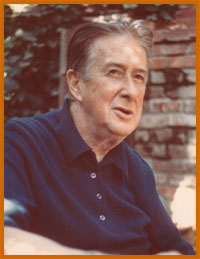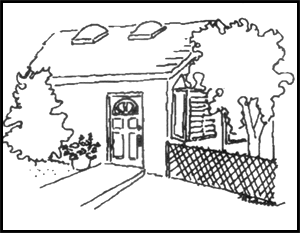History of the Center
A HISTORY OF THE COMMUNITY CENTER

Councilman Zev Yaroslavsky honors Dorothy River for a lifetime of community service to Beverly Glen, 2000
HOW LITTLE BEVERLY GLEN TOOK ON THE BIG DEVELOPERS
Around 1965, Los Angeles was enjoying another one of its historic boom-time development cycles. Sam Yorty, who never met a developer he didn’t like, was mayor. Major corporations were merging, diversifying and acquiring new businesses like crazy. Real estate development was becoming a hot profit opportunity for big industrial companies. Any open hillsides in that civic atmosphere were vulnerable to “improvement,” including Beverly Glen’s lovely undeveloped acres at the north end of the canyon. Glen residents counted the quiet stars at night and drank in the restorative airs of the fresh chaparral that surrounded them.
Alas! The U.S. Plywood Company bought the upper acres and drew up plans for installing nearly 1,200 new homes while taking out 150 existing historic Glen houses to make room for widening the boulevard to four lanes. This was planned to accommodate the sizable new population and its expected traffic. As compensation for virtually destroying our community the corporation offered the use of their planned running track and tennis courts.
The City Planning Commission approved. So did the City Council. Mayor Yorty was happy, too. Did someone say, “environment”? Who cared about that, except some canyon weirdos and nature nut cases? But Glen residents cared; they cared a lot, even as they lost their first appeal against the development before the city agencies. So they put their care, energy, money and eight years of a tough, lonely fight against the City, developers, profit-oriented industrialists and the courts to keep the Glen as a community in harmony with nature. And they won. How?
They sued, of course. At a meeting in Phil and Dossie Gilbert’s living room, Phil gambled and voluntarily pledged $100 of his own money to pay the lawyers and got the other 25 or so Glenites present to do the same. Thus the long, eight-year struggle began. The group’s objectives were to cut down the planned number of new houses, remove the road-widening plan, preserve the existing Glen houses, set up a non-profit organization and get money for building or acquiring a community center. This had been a long time dream of Les River – one which finally came true — but sadly, only after Les passed away. What happened during that eight-year fight that allowed tiny Beverly Glen to win against the assembled powers that opposed it? Three things: first, the lawsuit bought time to plough through all the legal maneuverings; two, during those years, environmentalism became a major and politically-important public concern; three, the election of a new environmental and politically-sensitive mayor, Tom Bradley, and new members of the City Council who were now listening to the increasing public alarm about development abuses.

Les River |
In 1973, after much effort by Glen residents — hearings, appearances, presentations, hours of donated time, meetings, papers, appeals, more hearings, including a specially-prepared video by Greg Heimer presented before the City Council, U.S. Plywood finally settled for $40,000, part of which provided the start-up for the long-awaited community center. The settlement amount was probably a pittance for U.S. Plywood, like a gnat gnawing on a deer’s flank, but it was a bonanza for the Glen. A lesser development of about 600 homes now sits in the upper Glen above Nicada Dr. and sometimes you can still smell chaparral after a night time rain. Deer, birds, rabbits and coyotes used to scurry among the roses of the landscaped houses and take their chances in the big traffic stream of the boulevard. But today they’re mostly gone, victims of progress. And down on Scenario Lane, the Les & Dorothy River Community Center now stands as a vital, active part of Glen life along with the Residents of Beverly Glen Association and Playgroup, symbols of what a determined community can do when they really care. |
(Abridged from The Glenite, Spring 2001)

HOW THE GLEN GOT A COMMUNITY CENTER
The Beverly Glen Association of 1982 thought it had realized a long-held dream of Glen residents when it purchased a small house on Scenario Lane to convert to a community center. Neighbors could assemble for meetings and events while the children of Playgroup, the Glen preschool, would have a permanent roof over their heads after years of wandering.
“It looked like a straightforward matter to add some floor area, make repairs, and get a variance to operate. We thought we were performing a community service and therefore the various public agencies would be helpful. Alas, not so,” said longtime resident, Doug Walstrom, who spearheaded the effort to get the place in order. Doug outlines the struggle as follows: “Starting on June 6, 1982, at a special meeting of RBG, Inc, the purchase of the property at 10409 Scenario Lane was approved. The price: $100,000, $15,000 down, 1st trust deed 13 1/2 percent. (The $15,000 was part of a settlement by the U.S. Plywood Company lawsuit) We closed escrow, and applied for zoning variance and conditional use permit as a community center and parent-cooperative nursery school. We cleaned up the yard, hired a contractor/architect, applied for a building permit and began work on February 23rd. On March 3rd, our building permit was refused by W.L.A. Building & Safety and work stopped. On March 22, our zoning variance and conditional use permit were disapproved by the West L.A. zoning commissioner. In April, we filed for appeal on the zoning variance. To expedite matters we changed drawings and applied for building permit as a single-family dwelling. On May 25, the building permit was granted. At a zoning appeal hearing at L.A. City Hall, there was an excellent presentation by Glen board members with written data, oral arguments, maps, and a professional-quality video tape summary. Then councilman Yaroslavsky spoke in support. The zoning variance was granted for five years, but a requirement for installation of curb, sidewalk and gutter was added. The Building & Safety office made a list of over 60 changes to the building. There was serious disagreement on what building code requirements should apply. Playgroup classes were now scheduled to begin. There was a glitch about the size of the handicap bathroom, and the fire inspector wanted us to change the doorknob. Total mileage: 41 trips to W.L.A. and 30 trips to downtown LA City Hall by various board members!”
The happy ending which Doug helped to bring about meant that all three organizations could now share the use of the Center. The Association is the parent organization dating back to the 1940’s. The LDRCC board manages the center and sponsors programs. Playgroup is a vintage Glen institution dating back at least half a century, and Playgroup rent helped to pay off the Center’s mortgage. Les River’s widow, Dorothy, had a permanent seat on the LRCC board, where she made absolutely certain that the Center served the Community until she died in 2006.
Abridged from The Glenite Autumn 2000


